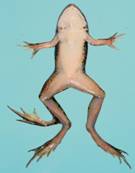|
Amphibians around the world are suffering from deformities, diseases and population
declines. USGS National Wildlife Health Center personnel have examined over 100 different
species of amphibians from national wildlife refuges, national parks, and private lands across the country to help
identify the causes of these problems and suggest effective solutions.
Frog malformations are the result of environmental factors affecting development during
early tadpole stages. USGS studies have shown that the range, complexity, and recurring patterns
found in hind limb malformations in frogs at several different locations suggest that both
site-specific and time-dependent influences contribute to the development of these malformations.
The variations in malformation type between sites suggest multiple causes are involved in this
worldwide problem; four major causes have been identified to date, including injuries from predators, a specific minute
parasite (fluke), nutritional deficiencies, and contaminants.
Both well-known (established) diseases and newly discovered pathogens can affect amphibian populations.
An alarming number of amphibian deaths at numerous sites were found to be caused by iridoviruses.
In the western United States, the endangered Wyoming toad and the boreal toad have been found to be
afflicted with a recently identified infection, a chytrid fungus. A newly identified pathogen, to be
named Anuraperkinsus emelandra, was identified as the cause of large-scale tadpole mortalities in ten
states; this new disease agent is now threatening the
last known breeding population of the endangered Mississippi gopher frog.
Every year, hundreds of eggs as well as larval and adult salamanders, frogs and toads from all over
the country are submitted for health screening to the USGS National Wildlife Health Center. This
nationwide health monitoring - part of the Amphibian Research and Monitoring Initiative - has lead
to the discovery of new diseases and the development of new molecular techniques to more rapidly
identify diseases, giving researchers a better idea of how to contain and manage
declining amphibian populations.
For more information about this topic, contact: Dr. Carol Meteyer, Phone: (608) 270-2462,
or Dr. David Green, Phone: (608) 270-2482, USGS, National Wildlife Health Center.
|


Examples of some amphibian deformities in northern leopard frogs.
|
|